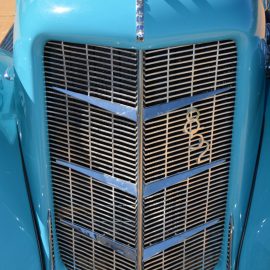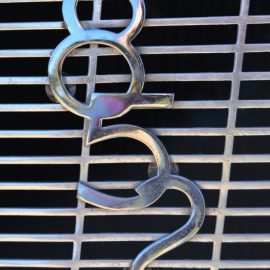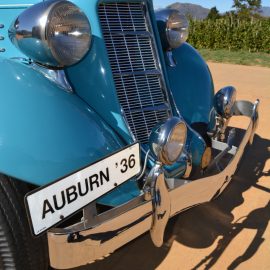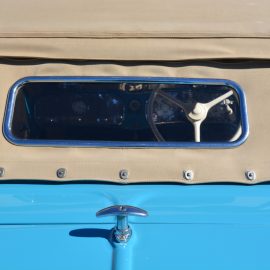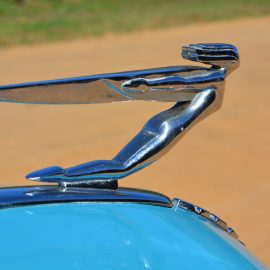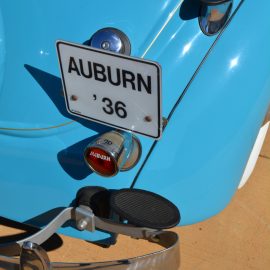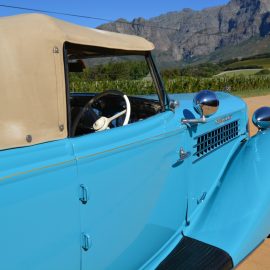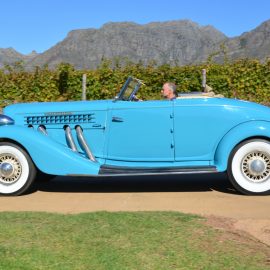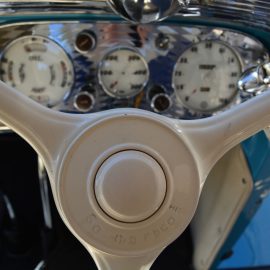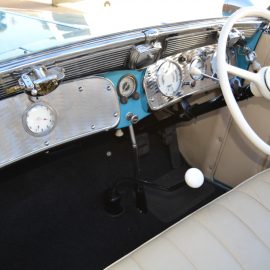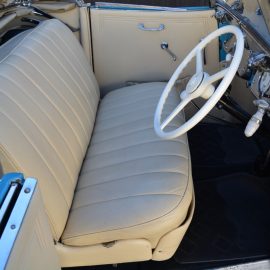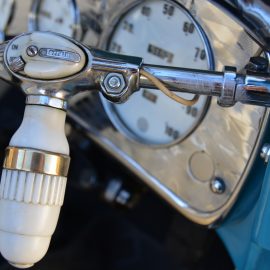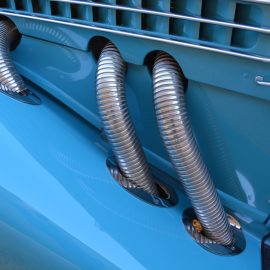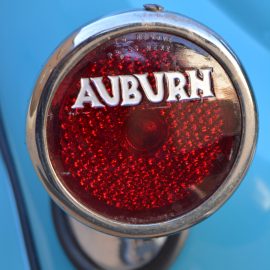
03 May Collection In Action: Auburn SC
The Great Depression following the Wall Street crash in 1929 left America in a sorry state and the country’s motor industry was badly affected as a result. The triumvirate of Auburn, Cord and Duesenberg was amongst the casualties and the surviving models make one wonder what could have been. Mike Monk relates the history and speeds along in one of the last to be produced, Auburn’s great straight-eight…
Auburn is a name more commonly associated with a luxuriant hair colour than automobiles because the motoring connotation applies to a relatively short-lived American manufacturer. The company’s star performer was actually the last to carry the name, the Model 8, which garnered Hollywood idol-like popularity in the mid-1930s but failed to save Auburn from closing down, albeit bowing out in style. In particular, the elegant roadsters epitomised high society and had the go to match the show thanks to a powerful straight-eight engine. But stunning looks and performance were not enough to ensure survival when America was still recovering from the 10-year Great Depression that began in October 1929.
First, a little history. The Auburn Automobile Company Incorporated emerged from the Eckhart Carriage Company founded in 1874 by wheelwright Charles Eckhart (who had worked for the Studebaker brothers) manufacturing wagons at a factory in Auburn, Indiana. Charles retired in 1893 leaving the business to his sons Frank and Morris, the offspring taking time out from wagon production to develop their own bespoke motor cars. In 1900, the Auburn Automobile Company was formed but it was only after the 1903 Chicago Motor Show that the company properly started business. The 1904 Auburn – a 2/4-seat touring car driven by a centrally-mounted horizontal single-cylinder engine and a two-speed planetary transmission – sold for $1 000, which was a substantial sum 117 years ago, and maybe why the company was not particularly successful.
A move into new, larger premises signified a modestly successful operation but a shortage of materials brought about by WW1 forced the factory to a halt. Immediately after the war, the Eckharts sold out to a group of Chicago investors (including William Wrigley Jr of chewing gum fame) who re-started production but sales – and profits – were not as anticipated and Auburn was in the doldrums again. In 1924 the group approached the maverick successful car salesman Errett Lobban Cord with a proposal for him to run the company with a clause that he could buy out controlling interest if he saved it. Cord accepted and it appeared a shrewd move on his part as he freshened-up unsold stock and began aggressive selling to such good effect that by the end of 1925 he was able to take full control and became company president.
During the next five years Cord backed a successful record-breaking run by Auburns at Atlantic City Speedway and Pikes Peak and followed this by taking over Duesenberg, thus inheriting brothers Frederick and August Duesenberg’s engineering skills, talent and the brand name in order to produce luxury cars. ‘Duesys’ were also successful in motor sport, which helped its image. Amongst other acquisitions, Cord bought engine manufacturer Lycoming to provide power plants for his products as he pressed on with his plan to produce a range of high-priced, high-tech luxury automobiles including the Model J Duesenberg. He even created a brand after his own name, the Cord L-29, which appeared in 1929 and was America’s first mass-produced front-wheel drive car.
Cord’s empire was on a roll, flying in the face of Black Tuesday, the Wall Street crash of October 1929, with Auburn sales almost doubling by 1931. US Business Week described the brand as offering “more car for the money than the public has ever seen”. The company even had an export programme for both six- and eight-cylinder models with “Vanity excused” as an advertising tag line.
During this time Cord employed Alan Leamy to design a new car and he came up with a range of models based on the company’s rigid straight-eight chassis that featured channel-section side members and cruciform bracing under the floor. The front axle was a forged beam and half-elliptic springs were used front and rear. Hydraulic dampers and Lockheed drum brakes were fitted to all four 16-inch wire spoke wheels. Body styles included a two-door Brougham, a coupé, a four-door sedan, a Phaeton sedan and a convertible, but it was the two-door, two-seat Speedster that captured the Hollywood spirit.
One of Auburn’s strong points was its use of the Lycoming GG straight-eight engine. The block was cast iron and the side-valve flat-head made from aluminium. A five-bearing crank and a bore/stroke of 77,78 x 120,6 mm gave a swept volume of 4 587cc. From 1935, the single Stromberg downdraft carburettor was force fed by a Schwitzer-Cummins centrifugal supercharger (that spun to 24 000 r/min) helping to deliver a peak power output of 150 hp (112 kW) at 4 000 r/min. A three-speed manual gearbox took drive to a Columbia two-speed rear axle, the ratios (a ‘fast’ 4,5:1 and a ‘cruising’ 3,1:1) selected by a steering-mounted control, effectively creating a six-speed transmission. Top speed was the magical 100 mph (161 km/h), a fact promoted to good effect in the car’s advertising material. A Straight Eight Speedster driven by David ‘Ab’ Jenkins at Utah averaged 100 mph for 12 hours to establish a US Stock Car record.
But there was a depression within the Great Depression and Auburn sales began to plummet. While Leamy’s styling was elegant, Duesy designer Gordon Buehrig, tweaked the model range’s looks to create the straight-eight’s last hurrah, the 1935/36 Model 8 Speedster with a boat-tail version as the pinnacle of fashion. Known as the 851 for 1935 and 852 for 1936 (there were no significant changes), the cars were sold for a loss-making $2 245 to attract showroom traffic to lesser, more affordable six- and eight-cylinder models, but only around 500 examples were sold during the two years. Auburn experimented with a Cummins diesel engine but the writing was already on the wall. Under scrutiny of America’s Bureau of Internal Revenue and Securities and Exchange Commission, Cord sold out his holdings and in 1937 Auburn – along with Cord and Duesenberg – went out of business.
FMM’s 1936 852 Speedster, one of the last of the line, was acquired from the Bertie Bester collection and has just undergone a mechanical refurbishment after the block became porous with resultant unwelcome mixing of oil and water. Replacement Lycoming engines are scarce but a standard straight-eight block was located in White River, purchased and together with the original motor sent to Bastick’s Engine Rebuilders in Woodstock, Cape Town for a rebuild. The new block’s porting had to be modified in order to accept the supercharged induction system but the crankshaft, con-rods and pistons were salvaged from the original engine.
The result is a motor that delivers a deep-throat rumble from its exhaust system that features four flexible stainless steel pipes protruding from the left side of the side-louvred bonnet, dropping through the mudguard and running underneath the running board before merging into a single tailpipe. The word SUPERCHARGED in big script above the louvres adds significantly to the appearance. The set-up looks dramatic and the exhaust’s basso profundo tone characterises the car’s screen-siren looks and Oscar-nominated performance. Why, it even has its own spotlight…
Hood erect – the rear window can be taken out – climbing aboard through the rear-hinged door and the interior has a comfortable, airy and lavishly equipped interior. Bright metal trim, elegantly styled instrumentation, ivory coloured steering wheel and knobs and taut, pleated leather upholstery and door trim ooze style and quality. But this is a car to be seen in, particularly in its striking sky blue paintwork, so after undoing a rather complex mechanism the substantial soft-top can be lowered and the thrill of al fresco motoring enjoyed.
Once the fiddly ignition/starter has been activated, the hefty 852 – it weighs around 1 700 kg – purrs away with an assurance that only quality-built cars display. The long-throw gearshift prefers unhurried operation but together with the dual-speed axle – dip the clutch and turn a dial in the centre of the steering wheel to smoothly change ratios – provides ground-eating performance from an engine working well within its capabilities. Ride and handling are taut thanks to the stiff chassis, the steering is meaty without being heavy at speed and the brakes are pin sharp having just been overhauled. Simply put, the 852 offers a red carpet ride.
In 1937, Auburn, along with Cord and Duesenberg, collapsed, yet the models all three brands are still talked about in revered tones. Today we can only look back and wonder ‘What if?’ and appreciate the survivors, of which this Auburn Straight-Eight Speedster is a prime example.
Visitor Note: The Auburn Speedster is currently on view in Hall A.
(This story is based on my article that first appeared in the Jun/Jul 2014 issue of Classic & Performance Car Africa magazine.)




